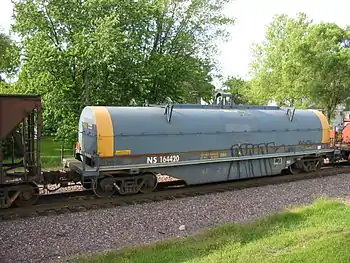Hood (rail transport)
A hood is a rigid cover to protect a load on a flat wagon, gondola or a coil car.[1] Gondola hoods developed from loose tarpaulin covers that were deemed unsatisfactory in damp climates;[2] but tarpaulins are still used as hoods in some cases.[3] For some gondola loads, hoods made of fiberglass were sufficient.[4] The hoods on coil cars were originally permanently attached to the cars when they were developed in the mid-20th century.[5]

A steel coil car owned by Norfolk Southern Railway. The load is covered by a hood
Hoods could also be mounted on wheels enabling them to slide out of the way toward one end of the car for loading.[6]
References
- "(untitled)". Chesapeake & Ohio Historical Newsletter. Vol. 14-17. Chesapeake & Ohio Historical Society. 1982. p. xiv – via Google Books.
- "(untitled)". The Railway Age. Vol. XXXIV no. 17. Chicago. October 24, 1902. p. 416 – via Google Books.
- European Union 0 609 655 AI, Heinrich Schnelting, Hugo Dipl.-Wirtsch.-Ing. Lemmer, issued 1997-05-07, assigned to WAGGONFABRIK TALBOT GMBH & CO.KG
- "D.5.1.1 Site to Site on Rail". Draft Environmental Impact Statement - Niagara Falls Storage Area, Long Term Management of the Existing Radioactive Wastes and Residues at the Niagara Falls Storage Site. Washington, D.C.: United States Department of Energy. August 1984. p. D-13 – via Google Books.
- "(untitled)". Headlight. Vol. 23-28. Public Relations Department, New York Central Railroad. 1962. p. 73 – via Google Books.
- United States 4,986,707, Karl-Dieter Reemtsema, Peter Wackermann, Guenter Ahlborn, Gerhard Kampmann, "Railroad Freight Car", issued 1991-01-22, assigned to Waggon Union GmbH
This article is issued from Wikipedia. The text is licensed under Creative Commons - Attribution - Sharealike. Additional terms may apply for the media files.